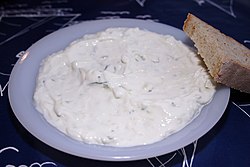 | |
| Type | Dip |
|---|---|
| Course | Appetizer |
| Place of origin | Greece |
| Main ingredients | Strained yogurt, cucumbers, garlic, olive oil, salt and sometimes lemon juice, dill or mint or parsley |
Tzatziki (Anglicised: /zɑːdˈziːki/; Greek: τζατζίκι [dzaˈdzici] or [dʒaˈdʒici]; Turkish: cacık [dʒaˈdʒɯk]; Albanian: xaxiq [citation needed]; Persian: ماست و خیار) is a Greek appetizer, also used as a sauce for gyros or doner kebabs. Tzatziki is made of strained yogurt (usually from sheep or goat milk) mixed with cucumbers, garlic, salt, olive oil, and sometimes lemon juice, and dill or mint or parsley.[1] Tzatziki is always served cold. While in Greece and Turkey the dish is usually served as an accompaniment, in other places tzatziki is often served with bread (loaf or pita) as part of the first course of a meal [citation needed].
Etymology
The name comes from the Turkish dish cacık, which contains many of the same ingredients but is considerably more liquid [citation needed].
Variations

Turkish cacık, the more diluted cousin of tzatziki, is usually served as an accompaniment to meat, though it is suggested as a soup or a salad also.[2] Usual ingredients are yogurt (from goat's milk), cucumber, salt, garlic, and dried and crushed wild mint.[3] When served as a meze (appetizer), it is of a thicker consistency, indistinguishable from tzatziki [citation needed].
In Cyprus, the dish is known as talattouri[4] (cf. tarator), and recipes often include less garlic and includes the herb mint, unlike the Greek counterpart.
In Bulgaria, the Republic of Macedonia and Serbia, the same dish is known as "dry tarator" (Bulgarian: сух таратор, Macedonian: сув таратур, Serbian: сув таратор), or as "Snezhanka" salad (салата "Снежанка"), which means "snow white salad", and is served as an appetizer. During preparation, the yogurt (Bulgarian: кисело мляко, Macedonian: кисело млеко, Serbian: кисело млеко) is hung for several hours in a kerchief and loses about half of its water (drained yogurt, Bulgarian: цедено кисело мляко, Serbian: цеђено кисело млеко, Macedonian: цедено кисело млеко). The cucumbers, garlic, minced walnuts, salt and vegetable oil are then added.
Similar dishes in Iraq are known as jajeek, normally served as meze alongside alcoholic drinks, especially Arak, an Ouzo-like drink made from dates.
A variation in the Caucasus mountains, called ovdukh, uses kefir instead of the yogurt, thus creating a refreshing summer drink. This can be poured over a mixture of vegetables, eggs and ham to create a variation of okroshka, sometimes referred to as a 'Caucasus okroshka'.
A similar dish is made in Iran, called mast-o-khiar literally meaning yogurt with cucumber. It is made using a thicker yogurt, which is mixed with sliced cucumber, and mint or dill (sometimes chopped nuts and raisins are also added as a garnish). Iranians take the dish a step further, substituting shallots, called mast-o-moussir [citation needed].
See also
References
- ^ Classic Greek Tzatziki Sauce
- ^ Shulman, Martha Rose (2007). Mediterranean Harvest: Vegetarian Recipes from the World's Healthiest Cuisine. Rodale. p. 106. ISBN 978-1-59486-234-2.
- ^ Grigson, Jane (2007). Jane Grigson's Vegetable Book. U of Nebraska P. pp. 239–40. ISBN 978-0-8032-5994-2. Retrieved 27 July 2010.
((cite book)): Unknown parameter|coauthors=ignored (|author=suggested) (help) - ^ Hoffman, Susanna (2004). The olive and the caper: adventures in Greek cooking. Workman. p. 149. ISBN 978-1-56305-848-6.
External links
| Breads | |||||||||||||
|---|---|---|---|---|---|---|---|---|---|---|---|---|---|
| Cheeses | |||||||||||||
| Dried meats | |||||||||||||
| Dishes |
| ||||||||||||
| Desserts | |||||||||||||
| Drinks | |||||||||||||